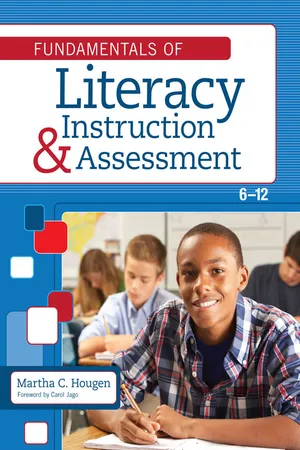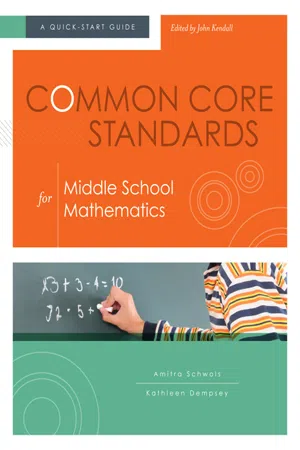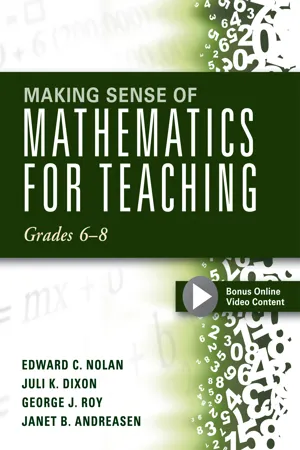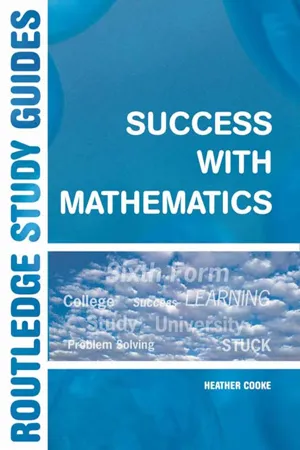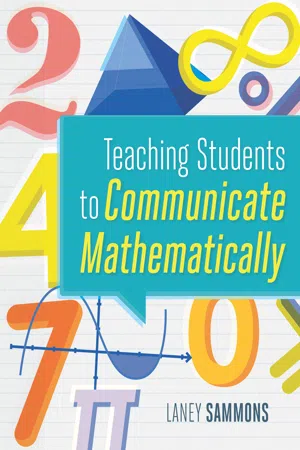Mathematics
Writing Equations
Writing equations involves expressing mathematical relationships using symbols and numbers. This process allows for the representation of various mathematical concepts, such as linear or quadratic relationships, in a concise and standardized form. Equations are used to solve problems, make predictions, and communicate mathematical ideas in a clear and precise manner.
Written by Perlego with AI-assistance
Related key terms
7 Key excerpts on "Writing Equations"
- Martha Hougen, Martha Hougen(Authors)
- 2015(Publication Date)
- Brookes Publishing(Publisher)
Effective instruction for elementary struggling readers: Research-based practices. Part I & Part II. Austin, TX: Texas Center for Reading and Language Arts; adapted by permission.)WRITING LIKE A MATHEMATICIAN
David Pugalee16 16 is a researcher who has explored the relationship between language and mathematics learning. Pugalee suggested that writing reinforces mathematical reasoning and problem solving and helps students understand the characteristics of effective communication, a perception also advocated by the National Council of Teachers of Mathematics (NCTM):17 17 “Writing in mathematics can also help students consolidate their thinking because it requires them to reflect on their work and clarify their thoughts about the ideas.” Strategic problem solvers, in addition to using a variety of strategies to interact with and solve mathematical problems, use writing to convey mathematical content, processes, and affect.18 18 In this section of the chapter, we describe what it means to write like a mathematician. We examine first the relationship between writing and mathematics; we then present examples of writing strategies that can be applied as students engage in mathematics problem solving.Mathematics and Writing
The Common Core State Standards (CCSS)19 19 address writing and mathematics. Critical Area 3 addresses writing and algebra and geometry.7.EE.2 Understand that rewriting an expression in different forms in a problem context can shed light on the problem and how the quantities in it are related. For example, a + 0.05a = 1.05a means that “increase by 5%” is the same as “multiply by 1.05.”20 20- eBook - ePub
Common Core Standards for Middle School Mathematics
A Quick-Start Guide
- Amitra Schwols, Kathleen Dempsey, John Kendall, John Kendall(Authors)
- 2013(Publication Date)
- ASCD(Publisher)
Chapter 4Expressions and Equations
. . . . . . . . . . . . . . . . . . . .The introduction to the Common Core standards' high school Algebra domain provides some useful definitions to help differentiate the two mathematical terms expression and equation:An expression is a record of a computation with numbers, symbols that represent numbers, arithmetic operations, exponentiation, and, at more advanced levels, the operation of evaluating a function…. An equation is a statement of equality between two expressions, often viewed as a question asking for which values of the variables the expressions on either side are in fact equal. These values are the solutions to the equation. (CCSSI, 2010c, p. 62)The middle school Expressions and Equations (EE) domain provides a critical bridge between content in the Operations and Algebraic Thinking domain in earlier grades and algebraic content students will encounter in high school. Figure 4.1 shows an overview of the Expressions and Equations domain's clusters and standards by grade level. - eBook - ePub
Making Sense of Mathematics for Teaching Grades 6-8
(Unifying Topics for an Understanding of Functions, Statistics, and Probability)
- Edward C. Nolan, Juli K. Dixon(Authors)
- 2016(Publication Date)
- Solution Tree Press(Publisher)
Much of the focus of the content of expressions, equations, and inequalities in the middle grades provides the groundwork for understanding algebra. As students make sense of real-world situations with unknown quantities that do and do not vary, they engage in algebraic reasoning. Students learn to write and solve expressions, equations, and inequalities, using context to help make sense of the language and structure of mathematics. Students in grades 6–8 must be able to write expressions and equations from context, solve equations and inequalities, investigate the concept of slope, and solve systems of equations.Writing Expressions and Equations From Context
In language, an expression communicates an idea. The same can be said for algebraic expressions—they communicate what contexts represent. Interpreting context lays a foundation for making sense of algebra. Consider the task provided in figure 3.7 .Figure 3.7: The pencils and highlighters task.You are cleaning out your desk at school. You find that you have 6 times as many pencils as highlighters. Write an equation for the number of pencils (p ) in terms of the number of highlighters (h ).How did you set up your equation? When posed with this task, many people write the equation 6p = h . How can you test this equation to see if it matches the context? When you start to substitute numbers for the variables in the equation 6p = h , what do you notice? If you let p equal 12, then h is 72. Does this make sense in the context of the problem? Returning to the context, you realize that there should be more pencils than highlighters, in fact, six times more. Instead of thinking about the relationship between the number of pencils and the number of highlighters, the equation 6p = h was written to follow the order of the items presented in the task; whereas, the equation 6h = p correctly represents the mathematical relationship. This is an important example of the need to combine the language of mathematics—and possibly the use of the key words - eBook - ePub
Well Played, Grades 6-8
Building Mathematical Thinking Through Number and Algebraic Games and Puzzles
- Linda Dacey, Karen Gartland, Jayne Bamford Lynch(Authors)
- 2023(Publication Date)
- Routledge(Publisher)
Chapter 5 Expressions and EquationsDOI: 10.4324/9781032683027-5What's the Math?
The study of expressions and equations helps students to transition from their work with number and operations in elementary school to the level of conceptual understanding needed for algebra. Previously, students have applied the properties of operations to rational numbers; now, they apply these ideas to variables. Success in this area is essential for later achievement in high school mathematics and in solving real-world problems. The National Research Council defines two key features of algebra as “(a) a systematic way of expressing generality and abstraction including algebra as generalized arithmetic and (b) a guided transformation of symbols such as we do when we solve equations by collecting like terms and using inverse operations” (NRC 2001 , 256).As students work with expressions and equations, there is ample opportunity for them to reason quantitatively and abstractly as well as to construct and understand viable arguments. Attention to justification helps students to connect prior knowledge about numbers to that of variables. According to Michael Cioe and his coauthors (2015), justification goes well beyond students showing their work, as it involves why, not just how. Playing and solving these puzzles and games in teams requires students to justify their thinking and to analyze the thinking of others.In sixth grade, students read, write, and evaluate expressions, and translate an expression such as 6 less than x to x – 6. Students use the properties of operations to recognize and generate equivalent expressions and to solve one-step equations and inequalities. They apply these ideas to the solution of real-world problems. In seventh grade, students extend these concepts and skills to the inclusion of rational numbers and the solution of multistep, real-world problems with positive and negative rational numbers. Students at this grade level also use mental computation and estimation strategies to assess the reasonableness of answers. In eighth grade, students solve linear equations efficiently and solve systems of linear equations with two variables. Students also make connections with other units of study as they use equations to express proportional relationships and apply their knowledge of functions in the interpretation of linear relationships (Gartland 2014 - eBook - ePub
- Heather Cooke(Author)
- 2003(Publication Date)
- Routledge(Publisher)
8 On the day, breathe slowly and deeply, speak clearly, and make eye contact with members of the audience. Do not talk with your back to the audience if writing on the board. Smile!WRITING MATHEMATICS
To a great extent, mathematics is a written subject. Even if a verbal explanation of something is possible, the listener often cannot hold it in mind unless something is written. For example, if you were to explain that ‘A complex number is a number of the form a +b i where a and b are real numbers and i is a square root of −1’, the chances are you would want to write down a +b i and i2 =−1 as these are the parts not so easily held in the mind. Part of the purpose of writing mathematics is to stabilise mathematical thoughts, so that they may be more readily understood and revisited.Sometimes the writing does the work for you, i.e. the conventional notation used is somehow designed to remind you of the steps you need to take. For example, in the calculation:the notation, once familiar, more or less makes the process automatic. When writing for other people in a formal way, bear the following points in mind.1 Before you start writing, make sure you know what you want to say, be clear about the mathematics in your own mind, then, as the March Hare in Alice in Wonderland directs, ‘say what you mean’ and mean what you say.2 Keep your purpose for writing and your audience in mind. For example, the purpose of an assignment is to show your tutor you know how to solve the problems or construct proofs, so you will want to include some detail of your working, but you can use standard symbols and concepts without explanation. If you are writing for your fellow students, you will want to include the sorts of reminders that you yourself needed to understand the material originally. If you are writing for the general public, you will have to explain your material without reference to specialist concepts or symbols.3 - eBook - ePub
Learning and Teaching Mathematics
An International Perspective
- Peter Bryant, Terezinha Nunes(Authors)
- 2016(Publication Date)
- Psychology Press(Publisher)
Children spend a good deal of their elementary mathematics careers in solving problems. However, they often arrive at answers spontaneously without being aware of the processes they have used to generate these answers (Booth, 1984). They almost never write an equation that represents the structural operations of the problem (Briars & Larkin, 1984). If they do write an equation, it usually represents the operations they carried out in arriving at the final answer to the problem. Usiskin (1989, p. 13) has characterized the equation-generation dilemma of beginning algebra students as follows:Consider the following problem: “When 3 is added to 5 times a certain number the sum is 40. Find the number.” … In solving these kinds of problems, many students have difficulty moving from arithmetic to algebra. Whereas the arithmetic solution (“in your head”) involves subtracting 3 and dividing by 5 [i.e., the solving operations], the algebraic form 5x + 3 involves multiplication by 5 and addition of 3 [i.e., using forward operations]…. That is, to set up the equation, you must think precisely the opposite of the way you would set it up using arithmetic.The algebra student must then go on to find the solution by manipulating the equation with another set of simplifying operations. Lesh, Post, and Behr (1987) have pointed out that the essential difference between solving problems arithmetically and solving them algebraically is the need in algebra first to describe and then to solve. We must add that an important aspect of this conceptual demand is to describe with “forward operations” rather than with the solving operations.Thus, one of the major obstacles in using algebra to solve problems is the translation of the verbal representation of the problem into an algebraic one. In addition to the use of forward operations, this activity also requires becoming aware of how to use a letter to represent an unknown quantity in the form of an equation that contains the unknown and other data of the problem situation. Bell, Malone, and Taylor (1987) have described some of the difficulties students encounter in this kind of activity. In their study involving three classes of 14-year-olds, they asked students to construct equations for problems such as the following (1987, p. 108): - eBook - ePub
- Laney Sammons(Author)
- 2018(Publication Date)
- ASCD(Publisher)
- The goal of education is not to learn shortcuts. At best, education prepares students for their future lives. They need to know how to think, reflect, and write. In writing about their mathematical thinking, students are practicing and refining important life skills.
- Although it may not always seem to be true at the time, in the long run, when students write about mathematics, it deepens their understanding. As a result, they retain what they learn and can also apply that knowledge to solve problems in many contexts. By writing, students "create, transform, mobilize, integrate, and secure what might otherwise be fragile knowledge. Writing whips learning into shape" (Benjamin, 2011, p. 87).
- Sometimes, you just have to slow down to go faster. When teachers take the time needed to have their students engage in the written exploration of mathematical ideas, students actually engage as mathematicians and assume greater responsibility for their own learning.
Following are suggestions for efficiently incorporating mathematical writing into math classes:- Incorporate mathematical writing into language arts writing instruction in self-contained classrooms.
- Assign fewer calculation problems, but have students justify their answers for some of them.
- Regularly include writing tasks at workstations if students work independently in a math workshop.
- Instead of giving a quiz as a formative assessment, ask students to do a "quick-write," telling everything they know about a math topic or concept.
- For homework, assign at least one writing task each night or designate a "writing night," where only writing tasks are assigned.
- Use writing as an activating strategy when beginning a unit or a lesson. Have students write about what they already know about the topic to help them activate their prior knowledge and provide writing practice.
Index pages curate the most relevant extracts from our library of academic textbooks. They’ve been created using an in-house natural language model (NLM), each adding context and meaning to key research topics.
